Application in landscape design
Spirea "Shirobana" is quite often used in the design of gardens and parks. It is worth noting that Genpei is a good neighbor to many plant species. This allows you to create a large number of decorative groups with the spirea. The main thing is to choose the right shrubs and flowers so that their appearance will please the eye from early spring, all summer and as long as possible in autumn.
The original composition will turn out if periwinkle, shade saxifrage, cerastium, lungwort are planted in the near-trunk circle of the Japanese spirea.
An interesting combination is obtained with bulbous species, especially in the spring. Spirea can be combined with daffodils, tulips
When creating a composition, it is important to remember that flowers should look harmonious in the overall picture.
The effectively described plant will look in combination with conifers. Here thuja, juniper, spruce will suit him.
The shrubbery can be used to form a dense hedge, curb or accentuate a slope.
The branches of the plant look great in bouquets. "Genpei", undoubtedly, is able to become an excellent decoration of the site, bringing in a special atmosphere.
A short overview of the "Shiroban" spirea in the video below.
Diseases and pests
The shrub is very resistant to diseases and pests. But if it's a hot summer or drought, a leafworm may start on it. She eats the leaves, they become weak, and the bush may die. To destroy the pest, use the drugs "Decis Profi" or "Fitoverm".


Aphids can attack spirea all summer long, especially if it's rainy. From aphids, the leaves will begin to curl up, as the pests suck the juice from the plant. Remove any damaged leaves and spray the bush with insecticide.
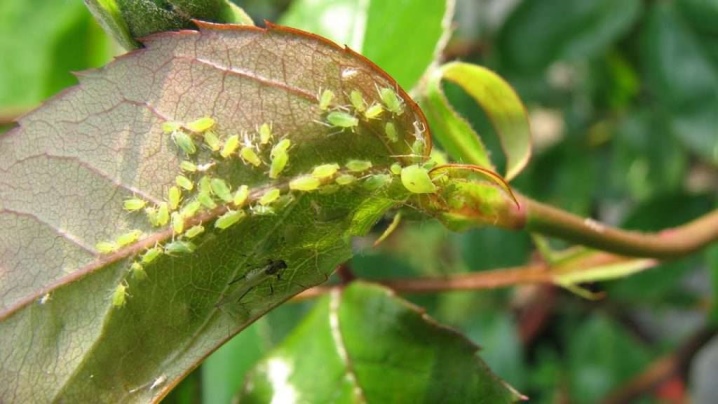
Dispose of fallen leaves from under the bush. There, female spider mites usually start up, which then climb onto healthy shrubs. They live under a leaf, and you can not immediately notice them. When the leaves begin to turn yellow and dry, only then can this pest be identified. In this case, remove the affected leaves and treat the foliage with the Acrex solution.

Whitefly and blue meadow sawfly are considered the most dangerous pests for spirea. For the fight, copper sulfate and a solution of laundry soap are used. If these remedies do not help, it is better to get rid of the shrub so that the infection does not spread to healthy plantings. Treat the infected area with Bordeaux liquid, and refrain from planting any planting on this place for a couple of years.
Take regular preventive measures to keep pests out.

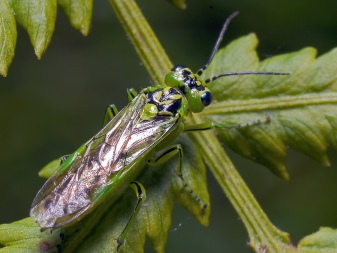
Reproduction methods
Genpei can be propagated by various methods, among which gardeners can choose the most convenient for themselves.
Layers
Layers for propagation of shrubs are used most often. This method consists in the fact that the strong branch is tilted as close to the soil as possible.
It is important that it does not break in the process. The end of the branch must be buried in the ground
In this position, the branch is fixed with a bracket or simply with a heavy object.
After the layer has a full-fledged root system, it can be separated from the main bush and transplanted to a permanent place. It is best to do layering in the fall in order to transplant the next year.
Cuttings
Cuttings are also great for breeding. With this method, the planting material takes root well, even if you do not use growth stimulants. First you need to take a good look at the bush and choose a shoot on it at the age of no more than a year. It must be cut almost to the very root.The branch will need to be divided into several parts so that each has no more than 6 sheets.
The length of the stalk should be about 15 cm. From the bottom of it you need to remove the foliage, and cut the remaining leaves by 50%. Then the cuttings are treated for 3-6 hours with the preparation "Epin", which is diluted at the rate of 1 ml per 2 liters of water. After processing, a growth stimulator, for example, "Kornevin", is applied to the lower sections of the cuttings.
Now you can plant cuttings in containers that are filled with light soil with sand. The deepening is carried out at an angle of 45 degrees. The containers must be covered with foil or jars and put in the shade. Seedlings must be sprayed several times a day. At the first drops in temperature, containers with cuttings are dropped into the soil and a significant layer of dry foliage is poured on top. With the arrival of warm days, cuttings are dug up and planted in open ground.
By dividing the bush
Among the vegetative methods, it is worth mentioning the division of the spirea. This method is suitable for both autumn and the first weeks of spring. This reproduction contributes to the rapid growth of the bushes. Among the shortcomings, it is worth noting the possible damage to the roots during division and the risk of infection. To avoid this, it is necessary to separate the bush with only sharp objects and disinfect the seedlings using a fungicide solution.
The method itself is that the bush is dug up along with the soil. Then the root system is immersed in a container of water to soften the soil. This will make it easier to separate the roots. As a rule, one plant is divided into 3-4 parts. It is desirable that each have an equal number of branches. After dividing, they are planted in the usual way, immediately to a permanent place.
Seeds
Seeds for reproduction of spirea are used extremely rarely, since the plant often loses its varietal qualities.
The collection of seeds is carried out in the fall, and then in the winter they are sown in containers with prepared soil. For effective germination, it is recommended to cover the containers with foil or glass and place them in a warm place. Periodically, the film or glass must be lifted for ventilation. With the appearance of sprouts, you will need to moisten them by spraying. Planting seedlings in open ground is carried out in the spring in the usual way.
Views

The shrub belongs to the pink family, the spirea subfamily
The genus has about 100 species, but not all of them are specially bred.
The most common representatives of the genus "Spirea":
Gray

Gray
One of the most common examples. It blooms with lush white flowers in early summer. There are so many of them that the greenery is practically invisible. It owes its name to the color of the leaves on the bush.
The branches are falling, crushed by the weight of the inflorescences. The maximum length is 185 cm. The decorative variety was bred by crossing the whitish-gray and St. John's worm spirea.
Average

Average
The habitat is the forests of Eastern Siberia and the Far Eastern regions. It grows in length above 2.2 m. It blooms in late spring with white flowers.
High resistance to drought and prolonged frost is noted.
Berezolistnaya

Berezolistnaya
The average height of the bush is 150 cm. It blooms with white inflorescences throughout the month of June. Found in Siberian forests.
Wangutta

Wangutta
Bred when crossing the Cantonese and three-bladed spirea. It is a giant shrub with a diameter of 2 m and a height of 2.2 m.
It has a long flowering period: almost all summer from June to mid-August.
Nippon

Nippon
It grows on the island of Honshu, reaches a height of 180 cm. The branches grow in a horizontal plane, forming a flooring for a voluminous crown.
The purple tints bloom in June, but disappear by the end of the month.
Gorodchaty

Gorodchaty
A convenient option for landscaping settlements. A low, up to 100 cm, shrub sits firmly in the ground. It is used to support floating soil.
Dubravkolistnaya

Dubravkolistnaya
Another representative who has earned recognition from the gardeners. She perfectly survives a haircut, allows you to create interesting compositions, natural installations.
Whitish pink petals appear in early summer for about 3 weeks.
Japanese

Japanese
Loves a warm, humid climate, but survives well in winter. Perhaps due to its small size. Branches not exceeding 1 m are covered with a snow coat and do not freeze.
An intense triple color scheme gives originality: pinkish, white and crimson.
Lovely

Lovely
A distinctive feature - the variety blooms twice a year in June and August. Moreover, the first stage is carried out on adult shoots, and the second on young ones.
White

White
The most popular species in Russia. It is known that it was grown in the 18th century. The shoots are brown, the leaves are pointed, the flowers are snow-white.
The maximum upward length is 170 cm.
Boomald

Boomald
Crossed type of Japanese and white-flowered spirea... The height of the bush is up to 80 cm. The color is from pinkish to deep red.
Long flowering period.
Douglas

Douglas
This variety grows in North America. It is an upright tree with sharp leaves elongated up to 10 cm.
It blooms for a month and a half, starting in July, with dark red inflorescences.
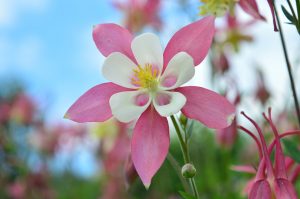
Aquilegia: the 25 most common species, the rules of planting, care and reproduction (70+ Photos & Videos) + Reviews
Peculiarities
Spirea Nippon came to Europe from the Japanese island of Shikoku. In the language of the historical homeland, its name sounds like "nippon". However, the name of the whole species of this shrub was given by the ancient Greeks.
They noticed that the branches of the plant bend towards the ground, and the leaves on them are arranged in a spiral order. For this, the shrub became known as spiraea ("bend, spiral")
Nowadays, the plant is officially called the Nippon spirea, in which both names are combined.
The scientific description of the nippon spirea is as follows.
-
The average height of the shrub is 1.5-2.5 meters. The plant reaches its peak of development in 10-20 years. The width options are the same as the height.
-
Branches are long, horizontal, arched. Oval leaves are alternately placed on them, the length of which is up to 4 cm.
-
The color of the leaves is dark green at the base and bluish green near the scalloped edging. In mid-November, the foliage becomes a deep red.
-
The shrub lives from 30 to 50 years.
-
Each year, the spirea grows 15-30 cm in height and width.
-
During the flowering period, the spirea is densely covered with globular inflorescences (up to 8 cm in diameter). The flowers are small (only 8 mm in diameter). It is no coincidence that it is considered the best pollinator for fruit crops. Spirea is also a valuable source of pollen for bees and other pollinating insects.
-
Spirea blooms in the first month of summer and blooms for only 15-25 days. During flowering, the plant looks spectacular both near and at a distance.
She is not afraid of frost, but snow drifts can disrupt the shape of the bush, therefore, for the winter, the spirea should be covered with a protective film or any other material.
Spirea care in the garden
Spireas are quite unpretentious and do not require any special care.
When growing them, attention should only be paid to watering, feeding and pruning.
Watering
 For normal growth and development of bushes, spireas need moderate watering. These plants do not like waterlogging and stagnation of water in the ground. But it is also impossible to dry out the soil under them, since the root system of plants is superficial. Therefore, it is recommended to water the shrub at least twice a month, watering one plant with ten liters of water at once. Young bushes are watered more often.
For normal growth and development of bushes, spireas need moderate watering. These plants do not like waterlogging and stagnation of water in the ground. But it is also impossible to dry out the soil under them, since the root system of plants is superficial. Therefore, it is recommended to water the shrub at least twice a month, watering one plant with ten liters of water at once. Young bushes are watered more often.
After watering around the spirea, the soil should be loosened and weeds should be weeded. These plants do not tolerate soil compaction and may even die from a lack of oxygen if the soil around them is not loosened in time. In autumn, the trunks are loosened and mulched with peat or compost.
Top dressing
Like all plants, spireas should be fed during care. This should be done at the beginning of the growing season, that is, in the spring. Special complex fertilizers are used, which should be used according to the instructions attached to them.
Pruning
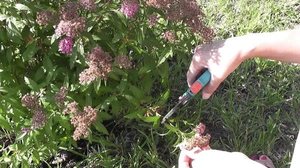 All spirea shrubs require timely annual pruning. But depending on the variety, it can be preventive or decorative.
All spirea shrubs require timely annual pruning. But depending on the variety, it can be preventive or decorative.
Plants blooming in spring are pruned immediately after flowering. Shoots containing inflorescences are shortened by half, thereby restoring the decorative effect of the bush. You should also cut off old, weak branches and lateral branches thickening the plant.
Spireas that bloom in summer are only pruned in spring. They renew the tops and remove the frostbitten twigs. Shoots are shortened to the first large buds. It is imperative to cut off the branches that strongly thicken the shrub. Mature plants are pruned more drastically. On a bush at the age of four years, shoots only 30 cm long are left.
In one place, spirea bushes can grow up to twenty years. You should think about replacing a specimen after a weak growth begins to appear on it after pruning.
Diseases and pests
Spirea is resistant to many diseases and various pests. However, there are those who can cause significant harm to her. Among them, the most dangerous is the spider mite. This is due to the fact that his eggs are very resistant to chemicals. Young shoots are most often attacked.
It is necessary to carefully examine the bushes in very warm weather, when the tick reproduces most intensively. You can notice the attack because the leaves have a yellow tint, they fall off. And also small holes and cobwebs can be seen on them. The plant should be treated for this type of parasite repeatedly until all individuals are destroyed. To do this, use drugs called "Phosphamide", "Karbofos".
In summer, ants can harm shrubs by walking aphids on them. Especially you need to be careful if the anthill is somewhere nearby. Aphids suck out the juice and damage the inflorescences. As a result, the plant looks unattractive and withers. To get rid of these pests, the bushes are most often treated with Pirimor.
At the end of spring, shrubs can be attacked by a rosaceous leafworm, which gnaws out the leaves. If you do not fight this pest, then in a short time you can stay with bare branches. Pirimor will also be effective against the leaf roll.
Experienced gardeners recommend combining spraying with rinsing pests with water from a hose. To destroy aphids and spider mites, you can use the folk method of dealing with the infusion of dissected hogweed. It is made from 1 kg of cow parsnip and 1 liter of warm water. You need to insist on the remedy for a day
When spraying with infusion, it is important to observe safety, since the hogweed is a poisonous plant
Diseases and pests
Spirea, unfortunately, is susceptible to attacks by some pests. In order to avoid such troubles, preventive measures should be taken that will preserve the decorative effect of the culture.
The most dangerous pest for spiraea is the spider mite. Its presence can be determined by the appearance of cobwebs, holes in the foliage, non-seasonal yellowing or the fall of greenery and inflorescences. A sick bush takes on an unsightly appearance. The fight against the tick must be started when the first signs appear. There are various means for this. Among them, malofos and phosphamide have proven themselves well, with solutions of which the entire plant is sprayed.
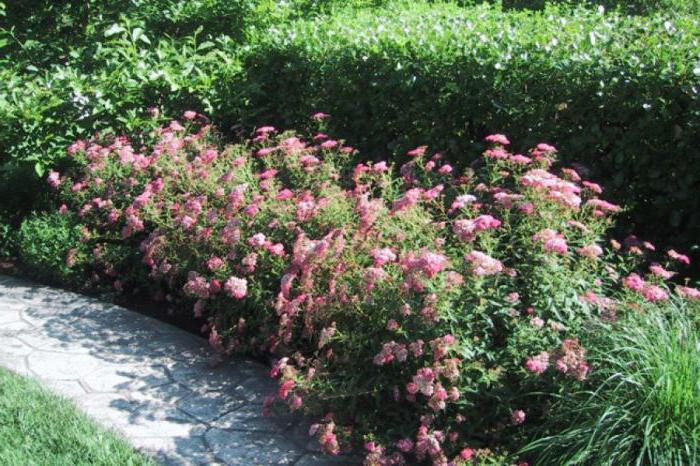
Spirea is often attacked by aphids, which spoil the peduncles. The appearance of such a pest can be determined by the presence of caterpillars and eaten foliage.To combat aphids, it is recommended to use prophylactic agents, among which chemical and natural substances are relevant. Pests do not like Pirimor very much.
Description of varieties of Japanese spirea, planting and care in the open field
Spirea Japanese gardeners fell in love with beautiful flowers and unpretentiousness. This ornamental shrub is suitable for creating hedges and decorating alpine slides. Breeders have bred more than 10 varieties of spirea, each of which is distinguished by a shade of flowers, length of branches and other characteristics. Moreover, each type of crop is grown according to the same rules.
General information about Japanese spirea
Japanese spirea (or meadowsweet) is a perennial plant with erect branches. Each bush is decorated with many bright flowers, collected in large shields. Regardless of the selected species, the culture quickly adapts to new growing conditions. The color of meadowsweet flowers varies widely: from white to pink and bright red.
Spirea is classified into two types: spring and autumn flowering. Each of these groups includes several varieties, including dwarf varieties, the height of the branches of which does not exceed 80 centimeters.
Varieties with a short description
Breeders have bred more than 10 varieties of Japanese spirea. The following varieties are popular among gardeners:
- Spirea Goldflame (Goldflame). It is characterized by small flowers and leaves that change color from brown to yellow-green during the season. The height of the bush does not exceed 80 centimeters.
- Spirea Macrophilus. A shrub with rounded leaves that change color to orange, yellow and purple in autumn. The macrophile reaches one meter in height.
- Jenpei (Genpei or Genpei). A number of sources call this variety as Shirobanu spirea. The Jenpey species is distinguished by dwarf (up to 60 centimeters) sizes and colors, the shade of which varies from pink to purple-red.
- Country ed. Eighty-centimeter shrub with erect shoots and dark pink flowers that appear in late summer.
- Golden princesses (Golden princess). The width of the crown and the height of the bush does not exceed 50 centimeters. The leaves on the bush in spring have a creamy yellow hue, which changes to bright yellow by summer, and to orange-red in autumn.
- Madzhik Karpet. The variety is distinguished by a pillow-like appearance and leaves that change color during the season and depending on the viewing angle.
- Crispus. Compact shrub up to half a meter high. The popularity of this variety is due to the light pink flowers that stay on the branches for two months.
- Little princesses. Also applies to small shrubs. Little's popularity is attributed to the bright pink flowers that contrast with the green foliage.
In garden plots, spirea of the varieties Neon, Flash, Darts, Albiflora are often planted. Among the popular species is Goldmund, which tolerates a drop in air temperature of up to -30 degrees.
Advantages and disadvantages
Among the advantages of Japanese spirea, gardeners distinguish the following qualities:
- long (up to a month) and violent flowering;
- rich foliage color;
- a wide variety of varieties;
- unpretentiousness;
- frost resistance;
- the ability to quickly adapt to new conditions.
The popularity of Japanese spirea is also explained by the fact that the shrub can be given various decorative forms. The description of the culture should be supplemented by the fact that the plant rarely gets sick. Basically, infection occurs due to abundant watering. In addition, the shrub is easy to propagate by cuttings or branches.


